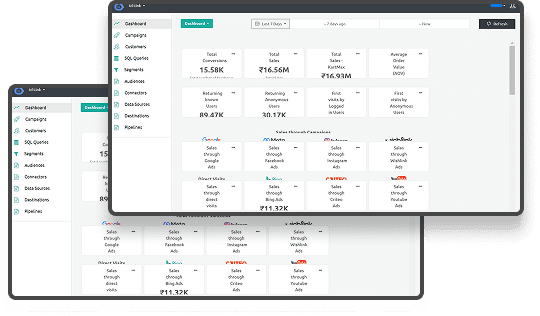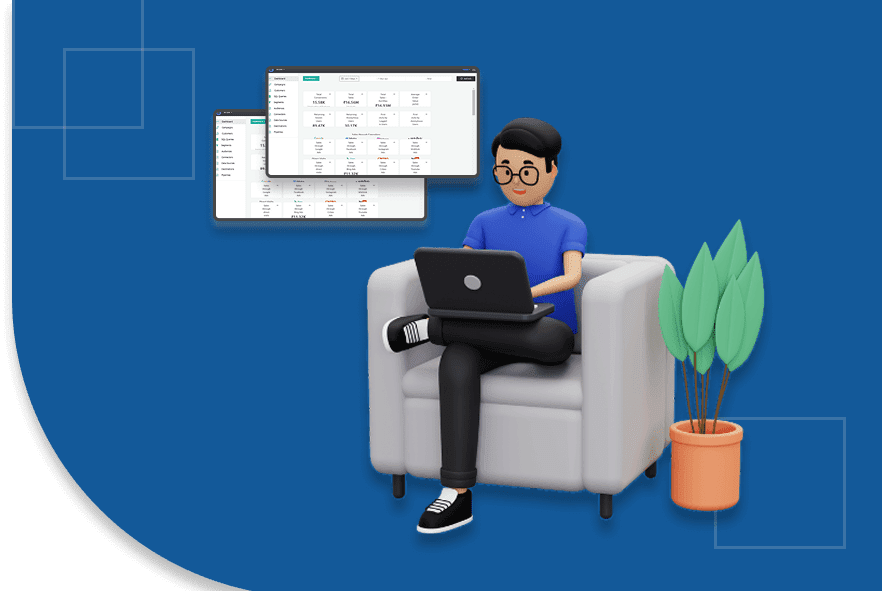Building a Unified Customer Profile: Understanding Your User
Picture having all your customer data in one place, easily accessible and actionable—how would that transform your marketing efforts? With a unified customer profile, you can gain a complete view of each customer, making your marketing strategies more effective and personalized.
Instead of juggling information from different sources, a unified profile brings everything together, helping you understand your users better and respond to their needs promptly.
Customers interact with brands across multiple channels—social media, email, websites, and more. Managing this data manually can be overwhelming and inefficient. A unified customer profile simplifies this process by integrating data from various touchpoints into a single, coherent view. This not only enhances your ability to track customer behavior but also ensures that your marketing messages are consistent and relevant.
Building a unified customer profile can create more personalized marketing campaigns, improve customer satisfaction, and drive higher conversion rates. This blog will explore the key components of a unified customer profile, its benefits, and the best tools to help you build and maintain these profiles effectively.
First, let’s understand about Unified customer profile.
What is a Unified Customer Profile?
A unified customer profile brings together all the information you have about your customers into one comprehensive view. Instead of having separate data sources for different channels like email, social media, and your website, a unified profile combines everything into a single, easy-to-access record. This approach helps you understand each customer’s behavior, preferences, and interactions with your brand.
For example, if a customer frequently interacts with your brand on Instagram, visits your website to read blog posts, and makes purchases through your mobile app, a unified profile will capture all these interactions. This holistic view allows you to deliver personalized experiences that resonate with your audience, enhancing their overall experience with your brand.
To learn more about how server-side tagging can aid in creating unified profiles, explore our detailed guide on server-side tagging.
Now that we've explored the basics, let's look into why this is significant.
Importance of a Unified Customer Profile
Understanding your customers deeply is crucial for effective marketing. A unified customer profile plays a vital role in achieving this by providing a single view of each customer. Here’s why it’s important:
- Enhanced Personalization: Customize your marketing messages and offers based on individual customer preferences and behaviors.
- Improved Customer Experience: Provide a seamless and consistent experience across all touchpoints, whether customers are interacting with you online or offline.
- Better Decision Making: Use comprehensive data to make informed decisions about your marketing strategies and business operations.
- Increased Efficiency: Streamline your marketing efforts by having all customer information in one place, reducing the time spent managing multiple data sources.
- Higher Conversion Rates: Deliver relevant content and offers that resonate with your audience, leading to increased engagement and sales.
A unified customer profile helps you move beyond generic marketing tactics. By understanding each customer’s unique journey, you can create more meaningful interactions that drive loyalty and long-term relationships.
Discover how real-time data streaming can enhance your unified profiles by providing instant insights into customer behavior.
Now that we’ve covered why campaign optimization is crucial, let’s focus on how to collect the data that will guide your decisions.
Data Collection Methods for Unified Profiles
Collecting the right data is the first step in building a unified customer profile. Here are some effective methods to gather comprehensive customer information:
- Website Analytics: Use tools like Google Measurement API to track how customers interact with your website, including pages visited, time spent, and actions taken.
- CRM Systems: Integrate your Customer Relationship Management (CRM) system to collect data on customer interactions, sales history, and support requests.
- Social Media Monitoring: Track engagement on platforms like Facebook, Instagram, and Twitter to understand customer interests and preferences.
- Email Marketing Platforms: Gather data on email open rates, click-through rates, and responses to personalize future communications.
- Mobile App Analytics: Use tools like mobile app data collection to monitor user behavior within your mobile applications.
- Surveys and Feedback Forms: Collect direct feedback from customers to gain insights into their needs and satisfaction levels.
- Transactional Data: Analyze purchase history and transaction details to identify buying patterns and preferences.
- Third-Party Data Sources: Supplement your data with information from external sources to enrich your customer profiles.
By using these methods, you can gather a wide range of data points that provide a detailed understanding of your customers. Ensuring that you collect data from multiple sources allows you to create a more accurate and comprehensive unified customer profile.
With our data collection methods in place, we can now build a unified customer profile.
Steps to Create a Unified Customer Profile
Building a unified customer profile involves several key steps to ensure that all your data is accurately combined and utilized. Here’s a simple guide to get you started:
1. Gather Data from Multiple Sources:
- Collect customer data from your website, CRM, social media, email campaigns, and other relevant platforms.
2. Clean and Organize Data:
- Once you’ve gathered data from multiple sources, the next step is to clean and organize it. High-quality data is crucial for accurate customer profiles
- Remove duplicates, correct errors, and standardize data formats to ensure consistency and accuracy.
3. Integrate Data into a Single Platform:
- Select a platform that can seamlessly connect with all your data sources.
- Utilize server-side tagging to enhance data accuracy and security. Server-side tagging helps in managing data flow more efficiently and reduces reliance on third-party tracking.
4. Analyze Customer Behavior:
- Use Real-Time Analytics to monitor customer interactions as they happen. Real-time insights allow you to respond quickly to emerging trends and changes in customer behavior.
- Examine the integrated data to identify patterns, preferences, and behaviors that can inform your marketing strategies.
5. Segment Your Audience:
- Divide your customers into segments based on shared characteristics to tailor your marketing efforts effectively.
6. Personalize Marketing Campaigns:
- Leverage first-party data to deliver personalized experiences without relying on third-party cookies. First-party data ensures that your personalization efforts are accurate and compliant with data privacy regulations.
- Consider using Ingest IQ to collect first-party data.
7. Continuously Update Profiles:
- Regularly refresh your customer profiles with new data to keep them current and relevant.
8. Ensure Data Privacy and Security:
Following these steps will help you build accurate and actionable unified customer profiles. This process not only enhances your understanding of your customers but also empowers you to deliver more effective and personalized marketing campaigns.
With those steps in mind, let’s explore how real-time data and AI take things even further.
Let’s break down the role of real-time data and AI in driving smarter, more effective campaign optimization.
Benefits of Real-Time Data and AI-Powered Profiles
Incorporating real-time data and AI-powered profiles into your marketing strategy can significantly enhance your ability to optimize campaigns and create personalized, data-driven experiences. Let’s look into the key benefits these technologies bring to the table:
- Instant Insights:
- Access real-time data to understand customer behavior as it happens, allowing you to respond quickly to trends and changes.
- Personalized Experiences:
- Use AI to analyze customer data and deliver highly personalized content and offers that match individual preferences.
- Predictive Analytics:
- Leverage AI to predict future customer actions, such as potential purchases or churn, enabling proactive marketing strategies.
- Improved Decision Making:
- Make informed decisions based on up-to-date data and comprehensive analysis provided by AI tools.
- Enhanced Customer Engagement:
- Engage customers with timely and relevant interactions that are informed by real-time data and AI insights.
- Efficiency and Automation:
- Automate routine tasks and data analysis, freeing up your team to focus on strategic initiatives.
- Scalable Personalization:
- Apply personalized marketing at scale, ensuring every customer receives tailored experiences without manual effort.
- Optimized Marketing Spend:
- Allocate your marketing budget more effectively by targeting the right customers with the right messages at the right time.
- Better Customer Retention:
- Increase customer loyalty by consistently meeting their needs and expectations through personalized interactions.
Integrating real-time data and AI-powered profiles into your unified customer profiles transforms how you interact with your audience. These technologies provide deeper insights and enable more precise and impactful marketing strategies.
For more on leveraging AI-powered insights, explore our resources on real-time analytics.
These benefits are clear, but let's also consider the challenges and how we can solve them.
Overcoming Challenges in Maintaining a Unified Customer Profile with Ingest Labs
Maintaining a unified customer profile comes with its own set of challenges. However, with the right strategies and tools, these obstacles can be effectively managed. Here are some common challenges and their solutions:
- Data Silos:
- Challenge: Different departments may store customer data in separate systems, making it difficult to create a unified profile.
- Solution: Implement a centralized platform like the one provided by Ingest Labs that integrates data from all sources, breaking down silos and ensuring seamless data flow.
- Data Quality Issues:
- Challenge: Inaccurate or incomplete data can lead to unreliable customer profiles.
- Solution: Regularly clean and validate your data using automated tools to maintain high data quality and accuracy.
- Integration Complexity:
- Challenge: Integrating multiple data sources can be technically complex and time-consuming.
- Solution: Choose tools with robust integration capabilities and pre-built connectors to simplify the integration process.
- Data Privacy and Compliance:
- Challenge: Ensuring customer data is handled in compliance with regulations like GDPR and CCPA.
- Solution: Use data privacy and compliance tools to manage consent, secure data, and adhere to legal requirements.
- Keeping Data Up-to-Date:
- Challenge: Customer information can quickly become outdated, reducing the effectiveness of your profiles.
- Solution: Implement real-time data streaming to continuously update and refresh customer profiles with the latest information.
- Scalability:
- Challenge: As your business grows, managing larger volumes of data can become challenging.
- Solution: Select scalable solutions like ones offered by Ingest Labs that can handle increasing data volumes without compromising performance.
- Technical Issues:
- Challenge: Technical glitches or system downtime can disrupt data collection and profile maintenance.
- Solution: Choose reliable platforms with robust tag monitoring and alerts to quickly identify and resolve technical issues.
- Resource Allocation:
- Challenge: Allocating sufficient resources to manage and maintain unified customer profiles.
- Solution: Automate as many processes as possible and consider outsourcing certain tasks to specialized providers like Ingest Labs.
By addressing these challenges with effective solutions, you can maintain accurate and valuable unified customer profiles that drive your marketing success.
For more insights on overcoming data management challenges, visit our article on tag monitoring strategies.
Conclusion
Building a unified customer profile is essential for understanding your users and delivering personalized marketing experiences. By consolidating data from multiple sources, you gain a comprehensive view of each customer, enabling more effective and targeted marketing strategies. Real-time data and AI-powered profiles enhance your ability to engage and retain customers, driving business growth and success.
Despite the challenges in maintaining unified profiles, the right tools and strategies, such as those offered by Ingest Labs, can simplify the process and ensure your data remains accurate and compliant. From data collection and integration to real-time insights and automation, leveraging these solutions allows you to focus on what matters most—building meaningful relationships with your customers.Ready to create a unified customer profile that transforms your marketing efforts? Contact us today to discover how Ingest Labs can help you build and maintain comprehensive customer profiles, enhance your marketing strategies, and achieve better results for your business.






